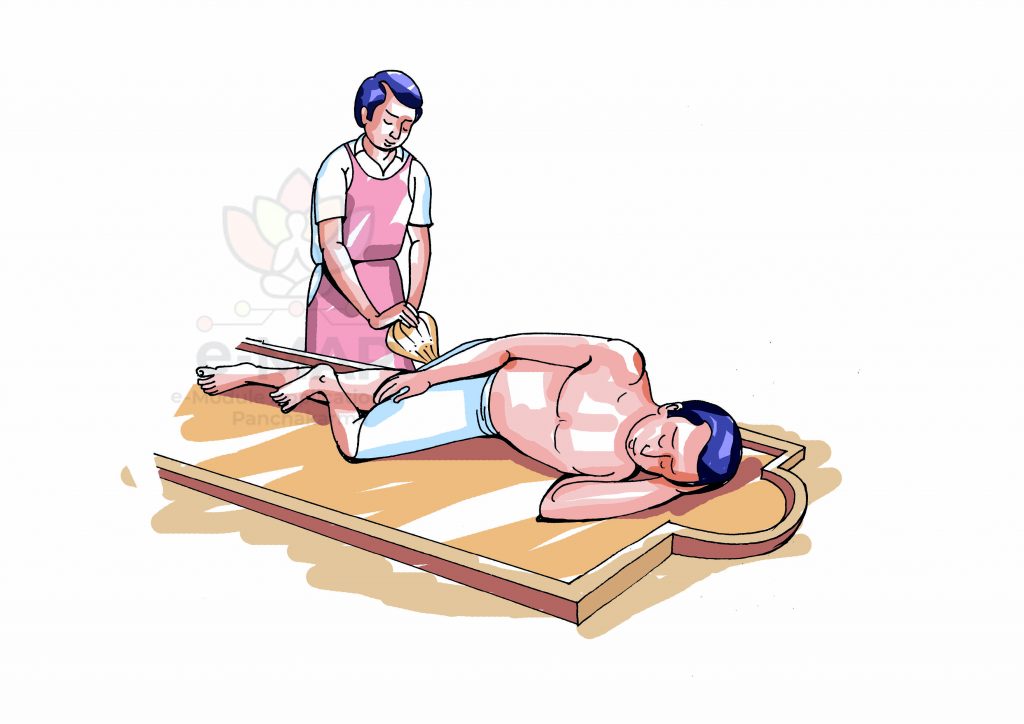
UG Module 6 - Lesson 13
BASTI KARMA

EXPLANATORY NOTES
नाभिप्रदेशं कटिपार्श्वकुक्षिं गत्वा शकृद्दोषचयं विलोड्य |
संस्नेह्य कायं सपुरीषदोषः सम्यक् सुखेनैति च यः स बस्तिः || (Cha. Si. 1/40)
In a properly administered Basti Karma, the Basti Dravya reaches up to Nābhi, Kaṭī, Pārśva, Kukṣi Pradeśa and a part of its Snehāmśa is absorbed into the body and the remaining Dravya churns accumulated Doṣa along with Purīṣa and eliminates them out.
आपादतलमूर्धस्थान् दोषान् पक्वाशये स्थितः|
वीर्येण बस्तिरादत्ते खस्थोऽर्को भूरसानिव|| (Cha. Si. 7/64)
Basti introduced into the Pakvāśaya acts upon the whole body and on every system of the body, from head to toe and draws out the impurities by its potency similar to the sun which evaporates the water from the earth by its heat.
The pharmacodynamics of Basti can be explained under following headings, they are –
1. Absorption in systemic circulation
2. Colon cleansing or excretory mechanism
3. On the basis of system biology
4. Neural stimulation of Gut brain
5. On the basis of Microbiome-gut-brain axis
ABSORPTION IN SYSTEMIC CIRCULATION
The colonic administration of the drugs causes absorption and transportation of the nutrients through transcellular and paracellular mechanism through the surface epithelium of rectum and large intestine. These sites are richly supplied by blood and lymph vessel. The Hemorrhoidal veins drains the area into portal and systemic circulations. These drugs and nutrients escapes the metabolism of the liver and dispersed in the body. This action of Basti is explained in the mode of action of Anuvāsana Basti where the Basti is supposed to have nutritive action similar to irrigation like effects on the plants causing their proper growth, flowering and fruit bearing. The nutritive action of Basti is also explained by the sequence of the Basti administered. Staring from bladder and umbilical region (first Basti), scalp and brain (second Basti), strength and complexion (third Basti), rasa Dhatu to Majjā Dhātu (fourth to ninth Basti), Śukra Dhātu (18th Basti). The Basti contents is known to correct the bacterial flora of the gut and helps in flushing out the toxins produced by the harmful bacterial and promotes the useful contents (bacterial products) formation within the Gut lumen.
COLON CLEANSING OR EXCRETORY FUNCTION
The colon cleansing function is attributed mainly by the Nirūha Basti. The site of cleansing are area around umbilicus region, lower back and laterals, and lower abdomen (~ colon). The unwanted waste is expelled in the form of faces, mucous lining, bile components, flatus, and urine. These are enhanced or evacuated with ease during the Basti sessions. This act of Basti is simulated with the action of sun causing absorption of water or moisture content from the earth. Thus, the evacuation of waste from the colon changes the dynamics of whole body and mobilizations of the content towards the gut lumen from rest of the body. Another verse also implies that only the waste is evacuated from the body just as the cloth selectively absorb the color during the dyeing process. Anuvāsana Basti is also believed to have some cleansing action, mainly the hydrophobic contents and the residuals 100 cc of the gaseous content present in the gut. There are many beneficial outcomes of the colon cleaning of the body, they are summarized as –
1. Removal of wastes and toxins from colon directly and whole of the gut indirectly.
2. Better absorption from the villi surface of the colon.
3. Reduce toxic loads from the other organs (liver, kidney, skin ) and aid in functional enhancement
ON THE BASIS OF SYSTEM BIOLOGY
All the organs of the body are connected at the system level and the greatly affect each other. Thus the cleansing action exerts a positive influences on whole of the body (whole of gut, liver, pancreas, gall bladder, then renal, respiratory, circulatory, integumentary system then systems, organs, tissue, cell ~ Koṣṭha, Strotas, Dhatu and Śākhās). Thus it could correctly quoted that the Basti causes the evacuation of Viśvakstitha Doṣa (~ waste present in whole body) Āpādatala Mūrdhasthita Doṣa ( from tip of foot to head region).
INFLUENCE THROUGH ENS (ENTERIC NERVOUS SYSTEM)
There are several neural components presence in the gut just similar to the brain and work independently apart from the limited interference of central nervous system through vagus nerve and myenteric plexus. These components had developed from the neural crest and referred as the enteric nervous system (ENS, intrinsic nervous system, gut brain, second brain etc.). These neural components are network of sheathed neural tissues and they outnumbered the tissues present in the Central nervous system. Since their structural and functional characteristics of the ENS and CNS are similar, they tend to influence each other greatly. The functioning of Basti seems to mechanically or chemically activate the ENS through Hit and Run Module or Touch and Go Theory. This effect might have extended influences on the CNS also through biochemical signaling.
ON THE BASIS OF MICROBIOME-GUT-BRAIN AXIS
Similar to the ENS, there is another aspect which might cause activation of biochemical signaling. That is Microbiome–gut–brain axis, the gut flora and the metabolites produced by them as byproducts may cause some neuroendocrine and neuroimmune activations.
IMPORTANT SLOKA
नाभिप्रदेशं कटिपार्श्वकुक्षिं गत्वा शकृद्दोषचयं विलोड्य |
संस्नेह्य कायं सपुरीषदोषः सम्यक् सुखेनैति च यः स बस्तिः || (Ch.Si. 1/40)
In a properly administered Basti Karma, the Basti Dravya reaches up to Nābhi, Kaṭī, Pārśva, Kukṣi Pradeśa and a part of its Snehāmśa is absorbed into the body and the remaining Dravya churns accumulated Doṣa along with Purīṣa and eliminates them out.
आपादतलमूर्धस्थान् दोषान् पक्वाशये स्थितः|
वीर्येण बस्तिरादत्ते खस्थोऽर्को भूरसानिव|| (Ch. Si. 7/64)
Basti introduced into the Pakvāśaya acts upon the whole body and on every system of the body, from head to toe and draws out the impurities by its potency similar to the sun which evaporates the water from the earth by its heat.



